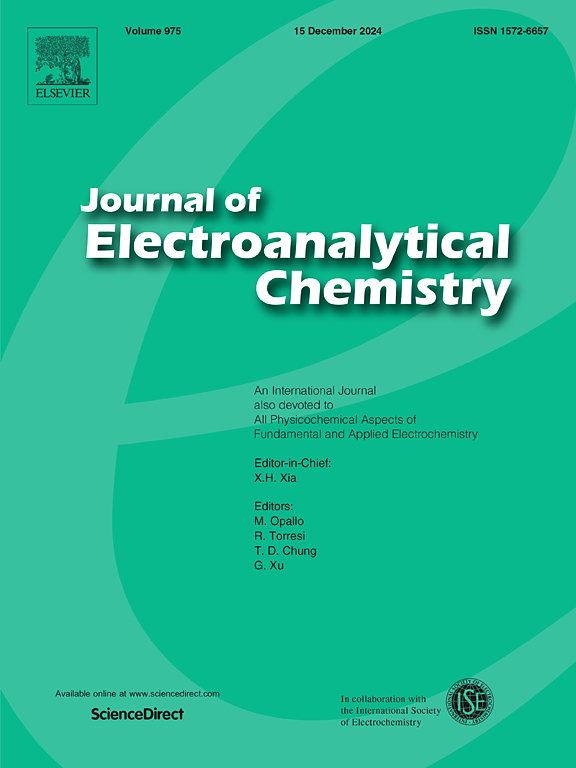Strongly coordinated synthesis of high-loading Ta2O5-supported Ru-Fe-Ni single-atom electrocatalyst with enhanced catalytic performance for urea synthesis via multifunctional graphene quantum dot integration
IF 4.1
3区 化学
Q1 CHEMISTRY, ANALYTICAL
引用次数: 0
Abstract
Industrial application of oxide-supported single atom catalysts remains many challenges, including poor economic feasibility, insufficient catalytic activity, limited electrical conductivity, and lack of functional diversity. The study reports a coordination-driven synthesis strategy for fabricating tantalum pentoxide-supported ruthenium‑iron‑nickel single atom electrocatalyst (Ru-Fe-Ni/Ta2O5@DHB-GQD) through metal ion coordination with aspartic acid and histidine-functionalized boron-doped graphene quantum dot (DHB-GQD), followed by controlled annealing. The resulting Ru-Fe-Ni/ Ta2O5@DHB-GQD offers atomic dispersion of Ru, Fe, and Ni on Ta2O5 with high metal loading of 5.6 wt%. Ta2O5 substrate features unique shear-structure with interconnected tunnels, enabling catalytic reactions to proceed simultaneously on the nanocrystal surfaces and within tunnel walls. Integration of DHB-GQD with Ru, Fe and Ni optimizes tunnel structure, reduces bandgap by 0.8 eV, and establishes efficient electron transfer pathways. Compared to pristine Ta2O5, engineered catalyst exhibits an enhancement in electrochemical active surface area (>4-fold), electrical conductivity (>53-fold), and K+ diffusion efficiency (>1564-fold). Experimental analyses coupled with density functional theory calculation demonstrates that trimetallic synergy of Ru, Fe and Ni significantly improves the catalytic activity and selectivity for reduction of NO3− and CO2 into urea. The Ru-Fe-Ni/ Ta2O5@DHB-GQD electrocatalyst achieves urea yield of 73.86 mmol g−1 h−1 with Faradaic efficiency of 48.5 %, surpassing previously reported counterparts.

通过多功能石墨烯量子点集成强协同合成高负载ta2o5负载的Ru-Fe-Ni单原子电催化剂,增强了尿素合成的催化性能
氧化物负载单原子催化剂的工业应用仍然面临许多挑战,包括经济可行性差、催化活性不足、导电性有限以及功能多样性不足。该研究报告了一种配位驱动的合成策略,通过与天门氨酸和组氨酸功能化的掺杂硼的石墨烯量子点(DHB-GQD)的金属离子配位,然后进行控制退火,制备五氧化二钽负载的钌-铁-镍单原子电催化剂(Ru-Fe-Ni/Ta2O5@DHB-GQD)。得到的Ru-Fe-Ni/ Ta2O5@DHB-GQD提供了Ru、Fe和Ni在Ta2O5上的原子分散,金属负荷量高达5.6%。Ta2O5衬底具有独特的剪切结构,具有相互连接的隧道,可以在纳米晶体表面和隧道壁内同时进行催化反应。DHB-GQD与Ru、Fe和Ni的集成优化了隧道结构,减小了0.8 eV的带隙,并建立了高效的电子转移途径。与原始Ta2O5相比,工程催化剂在电化学活性表面积(4倍)、电导率(53倍)和K+扩散效率(1564倍)方面表现出增强。实验分析和密度泛函理论计算表明,Ru、Fe和Ni的三金属协同作用显著提高了NO3−和CO2还原成尿素的催化活性和选择性。Ru-Fe-Ni/ Ta2O5@DHB-GQD电催化剂的尿素产率为73.86 mmol g−1 h−1,法拉第效率为48.5%,超过了之前报道的同类产品。
本文章由计算机程序翻译,如有差异,请以英文原文为准。
求助全文
约1分钟内获得全文
求助全文
来源期刊
CiteScore
7.80
自引率
6.70%
发文量
912
审稿时长
2.4 months
期刊介绍:
The Journal of Electroanalytical Chemistry is the foremost international journal devoted to the interdisciplinary subject of electrochemistry in all its aspects, theoretical as well as applied.
Electrochemistry is a wide ranging area that is in a state of continuous evolution. Rather than compiling a long list of topics covered by the Journal, the editors would like to draw particular attention to the key issues of novelty, topicality and quality. Papers should present new and interesting electrochemical science in a way that is accessible to the reader. The presentation and discussion should be at a level that is consistent with the international status of the Journal. Reports describing the application of well-established techniques to problems that are essentially technical will not be accepted. Similarly, papers that report observations but fail to provide adequate interpretation will be rejected by the Editors. Papers dealing with technical electrochemistry should be submitted to other specialist journals unless the authors can show that their work provides substantially new insights into electrochemical processes.

 求助内容:
求助内容: 应助结果提醒方式:
应助结果提醒方式:


